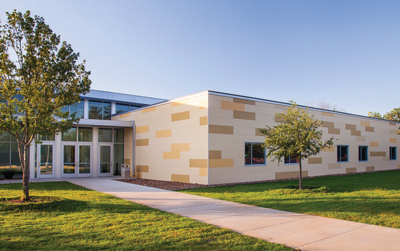Located in Uvalde, Texas, the Willie De Leon Civic Center recently experienced a major renovation, whose final result is a strong statement for fiber cement panels beyond the residential siding market. The civic center was originally built in 1968, as a tribute to the area’s most decorated soldier, who earned a Purple Heart during World War II. “This project and many others like it clearly demonstrate the changing perception within the architectural market of using fiber cement panels on commercial, multi-use buildings. Every architect that uses the fiber cement product likes the look and low-maintenance properties of the panels, and they really appreciate the Nichiha panels’ ease of installation,” says Jeff Locke, sales representative for Norcross, Ga.-based Nichiha U.S.A. Inc., which opened a fiber cement plant in Macon, Ga., in 2007.
 |
| The Willie De Leon Civic Center was retrofitted with approximately 15,000 square feet or about 1,700 Nichiha fiber cement panels. The majority of the 5/8-in. x 18-in. x 6-ft. panels was applied over existing brick. |
The lead architects on the project, Office 4 Architecture, were challenged to find a material that could re-imagine the existing structure, serve as an appropriated finish for the new additions, and tie the project together as a single building. After examining several alternatives and price points, which included staining/painting the existing brick, stucco, metal panels and fiber cement panels, the architects chose the Nichiha panel system. They were impressed by the design flexibility of Nichiha fiber cement panels as well as its price point. When learning about Nichiha through a local representative, Joe Neely and his team at Office 4 Architecture found that the Nichiha panels were relatively maintenance-free and could stand up to the elements. In addition, the architects felt that the Nichiha Illumination Series panel thickness made it a good choice for longevity and durability.
The finish of the Nichiha panels is a chemically set acrylic latex paint, which allows the architect to choose his colors without any up charge. The wide range of color options offered by the Nichiha Color Xpressions System combined with the modern appearance and ability to attach the Nichiha system to an existing wall space, were all deciding factors for the resurface and retrofit of the existing, outdated building.

“Because the budget was limited, stucco was a real consideration because its price point was very similar to the panel system. Metal panels were considered because of design flexibility, durability and the combination of composite insulation, but they were outside the project budget. In the end, the Nichiha panel combined many of the design flexibility qualities we liked about metal panels at a price point the project could afford,” commented Neely. “Nichiha fiber cement was superior to stucco because it allowed us flexibility to texture the surface, give the building scale, and unify both the old and new building components into a single architectural statement.” In addition to the Nichiha panels design aesthetics, the installation process was another important factor. Jared Cain of Rain King was responsible for the panel installation on the Civic Center. “The Nichiha panels were easy to layout, and once we got started, they installed extremely quickly and easily,” commented Cain. With the fiber cement panels, there was about a 25 percent cost savings compared to installing other wall panels in a similar fashion.
